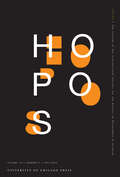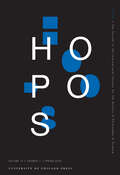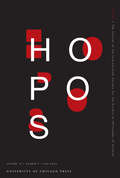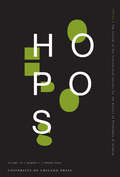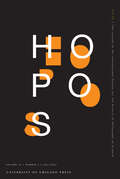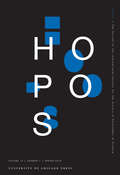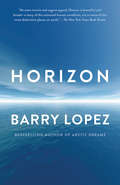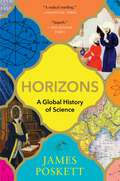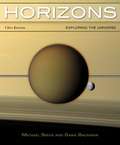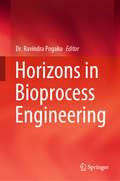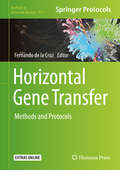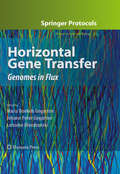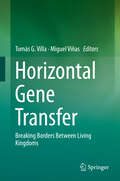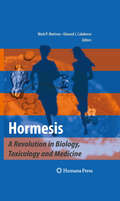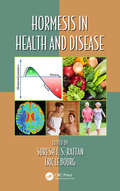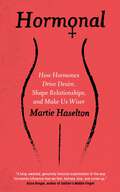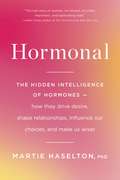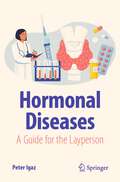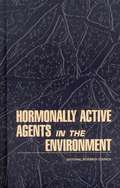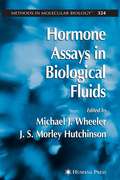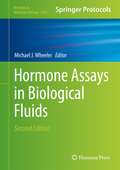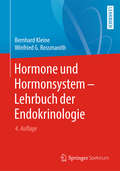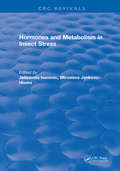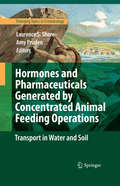- Table View
- List View
HOPOS: The Journal of the International Society for the History of Philosophy of Science, volume 12 number 2 (Fall 2022)
by HOPOS: The Journal of the International Society for the History of Philosophy of ScienceThis is volume 12 issue 2 of HOPOS: The Journal of the International Society for the History of Philosophy of Science. Presenting international, peer-reviewed scholarship on the history of philosophy of science, HOPOS explores connections across a range of social, economic, and political contexts. The work of philosophers of science is a central focus, as well as the development, interpretation, and impact of the philosophy of science as a discipline. The journal features articles, special issues, book reviews, and review essays of recent scholarship in growing areas of the field. HOPOS is the official journal of the International Society for the History of Philosophy of Science.
HOPOS: The Journal of the International Society for the History of Philosophy of Science, volume 13 number 1 (Spring 2023)
by HOPOS: The Journal of the International Society for the History of Philosophy of ScienceThis is volume 13 issue 1 of HOPOS: The Journal of the International Society for the History of Philosophy of Science. Presenting international, peer-reviewed scholarship on the history of philosophy of science, HOPOS explores connections across a range of social, economic, and political contexts. The work of philosophers of science is a central focus, as well as the development, interpretation, and impact of the philosophy of science as a discipline. The journal features articles, special issues, book reviews, and review essays of recent scholarship in growing areas of the field. HOPOS is the official journal of the International Society for the History of Philosophy of Science.
HOPOS: The Journal of the International Society for the History of Philosophy of Science, volume 13 number 2 (Fall 2023)
by HOPOS: The Journal of the International Society for the History of Philosophy of ScienceThis is volume 13 issue 2 of HOPOS: The Journal of the International Society for the History of Philosophy of Science. Presenting international, peer-reviewed scholarship on the history of philosophy of science, HOPOS explores connections across a range of social, economic, and political contexts. The work of philosophers of science is a central focus, as well as the development, interpretation, and impact of the philosophy of science as a discipline. The journal features articles, special issues, book reviews, and review essays of recent scholarship in growing areas of the field. HOPOS is the official journal of the International Society for the History of Philosophy of Science.
HOPOS: The Journal of the International Society for the History of Philosophy of Science, volume 14 number 1 (Spring 2024)
by HOPOS: The Journal of the International Society for the History of Philosophy of ScienceThis is volume 14 issue 1 of HOPOS: The Journal of the International Society for the History of Philosophy of Science. Presenting international, peer-reviewed scholarship on the history of philosophy of science, HOPOS explores connections across a range of social, economic, and political contexts. The work of philosophers of science is a central focus, as well as the development, interpretation, and impact of the philosophy of science as a discipline. The journal features articles, special issues, book reviews, and review essays of recent scholarship in growing areas of the field. HOPOS is the official journal of the International Society for the History of Philosophy of Science.
HOPOS: The Journal of the International Society for the History of Philosophy of Science, volume 14 number 2 (Fall 2024)
by HOPOS: The Journal of the International Society for the History of Philosophy of ScienceThis is volume 14 issue 2 of HOPOS: The Journal of the International Society for the History of Philosophy of Science. Presenting international, peer-reviewed scholarship on the history of philosophy of science, HOPOS explores connections across a range of social, economic, and political contexts. The work of philosophers of science is a central focus, as well as the development, interpretation, and impact of the philosophy of science as a discipline. The journal features articles, special issues, book reviews, and review essays of recent scholarship in growing areas of the field. HOPOS is the official journal of the International Society for the History of Philosophy of Science.
HOPOS: The Journal of the International Society for the History of Philosophy of Science, volume 15 number 1 (Spring 2025)
by HOPOS: The Journal of the International Society for the History of Philosophy of ScienceThis is volume 15 issue 1 of HOPOS: The Journal of the International Society for the History of Philosophy of Science. Presenting international, peer-reviewed scholarship on the history of philosophy of science, HOPOS explores connections across a range of social, economic, and political contexts. The work of philosophers of science is a central focus, as well as the development, interpretation, and impact of the philosophy of science as a discipline. The journal features articles, special issues, book reviews, and review essays of recent scholarship in growing areas of the field. HOPOS is the official journal of the International Society for the History of Philosophy of Science.
Horizon
by Barry LopezFrom the National Book Award-winning writer, humanitarian, environmentalist and author of the now-classic Arctic Dreams: a vivid, poetic, capacious work that recollects the travels around the world and the encounters--human, animal, and natural--that have shaped his extraordinary life. Poignantly, powerfully, it also asks "How do we move forward?"Taking us nearly from pole to pole--from modern megacities to some of the most remote regions on the earth--Barry Lopez, hailed by the Los Angeles Times Book Review as "one of our finest writers," gives us his most far-ranging yet personal work to date, in a book that moves through decades of his life as it describes his travels to six regions of the world: from the Oregon coast where he lives to the northernmost reaches of Canada; to the Galapagos; to the Kenyan desert; to Botany Bay in Australia; and in the resounding last section of this magisterial book, unforgettably to the ice shelves of Antarctica. As he revisits his growing up and these myriad travels, Lopez also probes the long history of humanity's quests and explorations, including the prehistoric peoples who trekked across Skraeling Island in northern Canada; the colonialists who plundered Central Africa; an Enlightenment-era Englishman who sailed the Pacific and a Native American emissary who arrived in Japan before it opened to the West. He confronts today's ecotourism in the tropics and visits the haunting remnants of a French colonial prison on Île du Diable in French Guiana. Through these journeys, and friendships forged along the way with scientists, archeologists, artists and local residents, Lopez searches for meaning and purpose in a broken world. With tenderness and intimacy, Horizon evokes the stillness and the silence of the hottest, the coldest and the most desolate places on the globe. It speaks with beauty and urgency to the invisible ties that unite us; voices concern and frustration alongside humanity and hope; and looks forward to our shared future as much as it looks back at a single life. Revelatory, powerful, profound, this is an epic work of nonfiction that makes you see the world differently: a crowning achievement by one of our most humane voices--one needed now more than ever.
Horizon
by Barry LopezFrom the National Book Award-winning writer, humanitarian, environmentalist and author of the now-classic Arctic Dreams: a vivid, poetic, capacious work that recollects the travels around the world and the encounters--human, animal, and natural--that have shaped his extraordinary life. Poignantly, powerfully, it also asks "How do we move forward?"Taking us nearly from pole to pole--from modern megacities to some of the most remote regions on the earth--Barry Lopez, hailed by the Los Angeles Times Book Review as "one of our finest writers," gives us his most far-ranging yet personal work to date, in a book that moves through decades of his life as it describes his travels to six regions of the world: from the Oregon coast where he lives to the northernmost reaches of Canada; to the Galapagos; to the Kenyan desert; to Botany Bay in Australia; and in the resounding last section of this magisterial book, unforgettably to the ice shelves of Antarctica. As he revisits his growing up and these myriad travels, Lopez also probes the long history of humanity's quests and explorations, including the prehistoric peoples who trekked across Skraeling Island in northern Canada; the colonialists who plundered Central Africa; an Enlightenment-era Englishman who sailed the Pacific and a Native American emissary who arrived in Japan before it opened to the West. He confronts today's ecotourism in the tropics and visits the haunting remnants of a French colonial prison on Île du Diable in French Guiana. Through these journeys, and friendships forged along the way with scientists, archeologists, artists and local residents, Lopez searches for meaning and purpose in a broken world. With tenderness and intimacy, Horizon evokes the stillness and the silence of the hottest, the coldest and the most desolate places on the globe. It speaks with beauty and urgency to the invisible ties that unite us; voices concern and frustration alongside humanity and hope; and looks forward to our shared future as much as it looks back at a single life. Revelatory, powerful, profound, this is an epic work of nonfiction that makes you see the world differently: a crowning achievement by one of our most humane voices--one needed now more than ever.
Horizons: The Global Origins of Modern Science
by James PoskettThe history of science as it has never been told before: a tale of outsiders and unsung heroes from far beyond the Western canon that most of us are taught.When we think about the origins of modern science we usually begin in Europe. We remember the great minds of Nicolaus Copernicus, Isaac Newton, Charles Darwin, and Albert Einstein. But the history of science is not, and has never been, a uniquely European endeavor. Copernicus relied on mathematical techniques that came from Arabic and Persian texts. Newton’s laws of motion used astronomical observations made in Asia and Africa. When Darwin was writing On the Origin of Species, he consulted a sixteenth-century Chinese encyclopedia. And when Einstein studied quantum mechanics, he was inspired by the Bengali physicist, Satyendra Nath Bose.Horizons is the history of science as it has never been told before, uncovering its unsung heroes and revealing that the most important scientific breakthroughs have come from the exchange of ideas from different cultures around the world. In this ambitious, revelatory history, James Poskett recasts the history of science, uncovering the vital contributions that scientists in Africa, America, Asia, and the Pacific have made to this global story.
Horizons: Exploring the Universe
by Michael A. Seeds Dana BackmanThe 13th Edition of HORIZONS means the proven Seeds/Backman approach and trusted content, fully updated with the latest discoveries and resources to meet the needs of today's diverse students.
Horizons in Bioprocess Engineering
by Ravindra PogakuThis book is divided into four parts that outline the use of science and technology for applications pertaining to chemical and bioprocess engineering. The book endeavors to help academia, researchers, and practitioners to use the principles and tools of Chemical and Bioprocess Engineering in a pertinent way, while attempting to point out the novel thoughts associated with the brain storming concepts encountered. As an example, the ability to use case studies appropriately is more important, to most practitioners.
Horizontal Gene Transfer: Methods and Protocols (Methods in Molecular Biology #2075)
by Fernando de la CruzThis book focuses on technologies used to study horizontal gene transfer (HGT) in prokaryotes. Beginning with a section on the detection and isolation of mobile genetic elements (MGEs), the volume continues with sections concentrating on the analysis of conjugation, transformation, and transduction in HGT as well as a series of methods to analyze the adaptation and evolution of MGEs, with special attention paid to bioinformatics tools. Written for the highly successful Methods in Molecular Biology series, chapters include introductions to their respective topics, lists of the necessary materials and reagents, step-by-step, readily reproducible laboratory protocols, and tips on troubleshooting and avoiding known pitfalls. Authoritative and practical, Horizontal Gene Transfer: Methods and Protocols serves as an ideal guide to the further study of this pervasive, all-important mechanism of genetic originality.
Horizontal Gene Transfer
by Lorraine Olendzenski Maria Boekels Gogarten J. Peter GogartenHorizontal gene transfer (HGT) events encompass processes as varied as the exchange of genetic material between microbes coexisting in the same environment, between symbiotic bacteria and their eukaryotic hosts, and the evolution of organelles by symbiosis, in which whole genomes are acquired. In Horizontal Gene Transfer: Genomes in Flux, expert researchers contribute an overview of HGT concepts as well as specific case histories that highlight the most current progress to inspire future work. Divided into three sections, the volume begins with an overview of terminology, concepts and the implications of HGT on current evolutionary thought and philosophy, and continues with methods involving computer and bioinformatics analyses of genomic data as well as molecular biology techniques for identifying, quantifying, and differentiating instances of HGT. A section of case studies follows, which provides detailed accounts of how HGT has shaped evolution across the diversity of organisms and organismal lineages. As a volume of the highly successful Methods in Molecular BiologyTM series, this work provides the kind of detailed description and implementation advice that is crucial for getting optimal results. Cutting-edge and thoroughly detailed, Horizontal Gene Transfer: Genomes in Flux examines how HGT has contributed to genome evolution and how understanding HGT impacts our ability to accurately reconstruct and comprehend the web-like evolutionary history in order to aid scientists in furthering their own research.
Horizontal Gene Transfer: Breaking Borders Between Living Kingdoms
by Tomás G. Villa Miguel ViñasThe book focuses on the evolutionary impact of horizontal gene transfer processes on pathogenicity, environmental adaptation and biological speciation. Newly acquired genetic material has been considered as a driving force in evolution for prokaryotic genomes for many years, with recent technical developments advancing this field further. However, the extent and implications of gene transfer between prokaryotes and eukaryotes still raise controversies. This multi-authored volume introduces various means by which DNA can be exchanged, covers gene transfer between prokaryotes and their viruses as well as between bacteria and eukaryotes, such as fungi, plants and animals, and addresses the role of horizontal gene transfer in human diseases. Aspects discussed also include the relevance for virulence and drug resistance development on one hand, and for the occurrence of naturally derived antibiotics and other secondary metabolites on the other hand. This book offers new insights to anyone interested in genome evolution and the exchange of DNA between the different domains of life, the genetic toolkit for adaptation and the emergence of multidrug resistant bacteria.
Hormesis
by Edward J. Calabrese Mark P. MattsonThis book stems from the belief that scientists and policy makers should be guided by the most reliable predictive models available, among which the hormetic dose response model has considerable evidence to support it, is very generalizable, has a strong mechanistic foundation and can be applied in the assessment of single agents and complex mixtures. For these reasons, the hormetic model should become the default in risk assessment. This book summarizes and analyzes the various positives of hormesis in an attempt to revel hormesis as a fundamental principle of toxicology, biology, and biomedical sciences as a whole. A focused discussion of how acceptance of the hormedis based model of toxicology would affect environmental standards and clean up values is mounted. A panel of scientists has been recruited to critically evaluate the hormetic dose response model and its comparison with current default models in their individual fields, including cellular biology, evolutionary biology, gerontology, and pharmacology. In-depth investigations are provided into how biological systems respond to increasing doses of environmental toxins while attempting to understand how cells respond to stress in the contexts of aging and neurological disorders.
Hormesis in Health and Disease (Oxidative Stress and Disease)
by Suresh I. S. Rattan Éric Le BourgSome mild stresses have positive effects on survival and aging as shown in animal models. There is also a large body of research that demonstrates these hormetic effects on aging, health, and resistance to severe stresses and diseases in human beings. However, the data are dispersed in the literature and are not always interpreted as hormetic effec
Hormonal: How Hormones Drive Desire, Shape Relationships, and Make Us Wiser
by Martie HaseltonProvocative, ground-breaking and entertaining, the world&’s leading expert on sexuality and the ovulation cycle reveals the hidden intelligence of hormones.In this paradigm-shifting book, Martie Haselton explains how hormonal intelligence works - both its strengths and its weaknesses - and shows women how to track and understand their desires, fears and perceptions with a radical new understanding of the biological processes that profoundly influence our behaviour. Rigorously researched, entertaining and empowering, Hormonal offers women deep new insights into their bodies, brains and relationships, and will encourage women everywhere to embrace the genius of female biology.
Hormonal: The Hidden Intelligence of Hormones -- How They Drive Desire, Shape Relationships, Influence Our Choices, and Make Us Wiser
by Martie HaseltonThe hidden intelligence of hormones and their role in empowering women to succeed sexually, reproductively, and socially.Did you know women walk more, eat less, socialize more, meet more men, dance more, and flirt more when they're ovulating? Or that PMS may have evolved to get rid of boyfriends with unfit sperm? Behind the "fickle" differences in what women find sexy about men, or what they like to wear, there's a hidden adaptive intelligence that has been shaped over eons. In this provocative and paradigm-shattering book, Martie Haselton, the world's leading researcher on sexuality and the ovulation cycle, takes a deep, revealing look at the biological processes that so profoundly influence our behavior and sets forth a radical new understanding of women's bodies, minds, and sexual relationships, one that embraces hormonal cycles as adaptive solutions to genuine biological challenges. At the core of Hasleton's new Darwinian feminism is her remarkable discovery that humans, like our animal cousins, possess a special phase of sexuality, called estrus, which comes with a host of physiological and behavioral changes.Rigorously researched, entertaining, and empowering, Hormonal offers women deep new insights into their bodies, brains, relationships, and affairs, allowing them to make better-informed choices about sex, marriage, friendship, contraception, and more. Above all, Hormonal is a clarion call to appreciate and embrace the genius of female biology.
Hormonal Diseases: A Guide for the Layperson (Copernicus Books)
by Peter IgazWritten by a recognized expert in the field, this accessible book acquaints the lay reader with the main features of hormonal diseases, their diagnosis and treatment. From gigantism and dwarfism to polycystic ovary syndrome, overactive thyroid and many more; it also explains what specialists in endocrinology do - and why - when diagnosing and treating patients.Each chapter gives a short introduction to the relevant hormonal disease, with information about the symptoms, diagnosis and treatment presented in an easily comprehensible question and answer format. Simple but accurate diagrams are used to visualize the information. The book clarifies important issues and helps patients to make informed decisions. Last but not least, it includes some current hot topics in endocrine practice as well as fascinating historical facts. It is a must-read for everyone interested in the fascinating world of hormones and their disorders.
Hormonally Active Agents in the Environment
by National Research CouncilSome investigators have hypothesized that estrogens and other hormonally active agents found in the environment might be involved in breast cancer increases and sperm count declines in humans as well as deformities and reproductive problems seen in wildlife.This book looks in detail at the science behind the ominous prospect of "estrogen mimics" threatening health and well-being, from the level of ecosystems and populations to individual people and animals. The committee identifies research needs and offers specific recommendations to decisionmakers.This authoritative volume: Critically evaluates the literature on hormonally active agents in the environment and identifies known and suspected toxicologic mechanisms and effects of fish, wildlife, and humans.Examines whether and how exposure to hormonally active agents occurs--in diet, in pharmaceuticals, from industrial releases into the environment--and why the debate centers on estrogens.Identifies significant uncertainties, limitations of knowledge, and weaknesses in the scientific literature. The book presents a wealth of information and investigates a wide range of examples across the spectrum of life that might be related to these agents.
Hormone Assays in Biological Fluids
by J. S. Hutchinson William D. Fraser Michael J. WheelerExpert researchers who have developed and applied significant new assays describe in step-by-step detail a variety of methods for measuring a broad variety of hormones, related peptides, and synthetic steroids in various biological fluids. The hormones measured range from glucocorticoids in biological fluids, urinary steroids, aldosterone in blood, and plasma renin activity, to gut hormones in plasma, melatonin, prolactin, 6-sulfatoxymelatonin, and androgens in blood, saliva, and hair. The emphasis is on noncommercial assays so that investigators can set up novel methods suited to their special needs. Commercial assays are also described for comparative purposes. Tutorials on radioimmunoassay, gas chromatography-mass spectrometry, high-performance liquid chromatography, and PCR techniques help the reader to choose the best method for his or her purpose.
Hormone Assays in Biological Fluids
by Michael J. WheelerHormone measurement is necessary for the diagnosis of a wide range of clinical conditions and is essential for monitoring the effectiveness of treatment. As the number of hormone requests in the clinical field rises exponentially, it has become imperative to create hormone assays accessible to researchers with a varied range of equipment. Hormone Assays in Biological Fluids, Second Edition reviews common techniques used to measure hormones as well as relatively new methods such as tandem mass spectrometry. Additionally, subsequent chapters detail methods for a broad range of hormones; Techniques and principles covered are transferable to a wide range of substances across species. Written in the successful Methods in Molecular Biology series format, chapters include introductions to their respective topics, lists of the necessary materials and reagents, step-by-step, readily reproducible protocols, and notes on troubleshooting and avoiding known pitfalls. Authoritative and easily accessible, Hormone Assays in Biological Fluids, Second Edition will serve students, technologists, laboratory scientists, and researchers looking to apply, or attain a greater understanding of, methods for measuring hormones.
Hormone und Hormonsystem - Lehrbuch der Endokrinologie: Lehrbuch Der Endokrinologie (Springer-lehrbuch Ser.)
by Bernhard Kleine Winfried RossmanithDie technischen Fortschritte und neuen Möglichkeiten der molekularen Biologie – Genomanalysen, Expressionsanalysen, konfokale Lasermikroskopie, Proteomics – lassen die Physiologie von Wirbeltieren, genauso wie die von Nicht-Wirbeltieren, in einem neuen Licht erscheinen. Bei der Darstellung der Endokrinologie von Mensch und Tier wird dieser Entwicklung Rechnung getragen: Die Schwerpunkte liegen auf Hormonbiochemie, Hormonphysiologie, Hormonrezeptoren, endokrinen Organen und Regelkreisen und der Regelung endokriner Rhythmen. Die Betrachtung des Hormonsystems reicht von seinen Ursprüngen bei Invertebraten, seiner Evolution, den Wechselwirkungen mit Nerven- oder Immunsystem bis zu Stoffwechselstörungen bei menschlichen Gen-Defekten. Die 4. Auflage ist deutlich erweitert. Das Thema Stoffwechsel nimmt, verteilt über mehrere Kapitel, eine wesentlich größeren Raum ein. Komplett neu ist auch die Embryologie der endokrinen Organe.
Hormones and Metabolism in Insect Stress
by Jelisaveta IvanovicThis book discusses the effects of both natural (e.g., temperature, humidity, and lack of food) and man-induced stressors (e.g., pollution) on insects. Insect neurohormones and metabolism are emphasized, although all aspects of insect biology are examined. The role of ecdysteroids and juvenile hormones in response to thermal and other stressors is featured, and population studies in insect stress are presented. Entomologists, ecologists, ecophysiologists, physiologists, applied entomologists and others will find Hormones and Metabolism in Insect Stress an important reference resource.
Hormones and Pharmaceuticals Generated by Concentrated Animal Feeding Operations
by Amy Pruden Laurence S. ShoreHormones and Pharmaceuticals Generated by Concentrated Animal Feeding Operations: Transport in Water and Soil examines how hormones, antibiotics and pharmaceuticals generated from concentrated animal feeding operations (CAFOs) of cattle, poultry, swine and aquaculture are transported in water and soil. Little is known of the environmental fate of the tons of physiologically active steroid hormones released each year. In their own regard, in the last 20 years considerable attention has been given to a wide variety of natural and anthropomorphic agents known as endocrine disrupting compounds (EDCs). Until the contribution of steroid hormones to the environment are better defined, it will be difficult to quantify the exact impact of EDCs. While some advances in the understanding of the fate of these compounds in water has been made, little is known about the processes that govern their transport in soil or how they eventually reach groundwater. As this book discusses extensively, it is somewhat of a mystery how steroids, with their lipophilic nature, strong binding to humic acids and extensive metabolism by soil bacteria, can be transported through even a few centimeters of soil, let alone 20 to 40 meters to the groundwater. With respect to antibiotics, the emphasis is on their fate and transport in the environment and on the emergence of antibiotic resistant bacteria. Impacts on soil ecology, including the impact of antibiotics on the metabolism of other active agents, is also discussed. Similarly, the acaricides and insecticides used in animal husbandry are widely used and their environmental pathways have been studied and have significant impacts on soil and dung ecology. Active compounds with potential environmental impacts, such as growth promoters generated from CAFOs, are described. However, because little is known of their environmental fate, emphasis is placed on defining the gaps in our knowledge and defining their possible effects.
